Are you planning a trip to the United States? A visa, also known as a visum, is essential for entry into the country. But how can you navigate the complex visa application process and ensure a quick and easy approval?
In this comprehensive guide, we will walk you through the steps of applying for a visa to the USA. Whether you’re traveling for business or pleasure, our tips and insights will help you secure your visum without unnecessary hassle or delays. So, let’s dive in and get you on your way to experiencing all that the USA has to offer!
Key Takeaways:
- Applying for a visa to the USA is a necessary step for travelers wishing to enter the country.
- The visa application process can be complex but can be simplified with proper preparation and understanding of the requirements.
- This comprehensive guide will provide you with valuable tips and insights on how to secure your visum quickly and easily.
- By following the steps outlined in this guide, you can increase your chances of obtaining a visa to the USA and embark on your journey with confidence.
- Remember to review the specific requirements for your visa type and consult the official guidelines provided by the U.S. embassy or consulate in your country.
Understanding the B-1/B-2 Tourist Visa
The B-1/B-2 tourist visa is a nonimmigrant visa that allows individuals to enter the United States temporarily for business or tourism purposes. Whether you’re coming for a business conference or planning a family vacation, this visa enables you to experience the diverse attractions and opportunities that America has to offer.
To obtain the B-1/B-2 tourist visa, it is important to understand the USA visa process and meet the necessary US visa requirements. By familiarizing yourself with the application process, you can ensure a smooth and successful visa application experience.
USA Visa Process
The USA visa process for the B-1/B-2 tourist visa involves several steps. You will need to complete the online Nonimmigrant Visa Application, Form DS-160, and pay the required application fee. After submitting your application, you will need to schedule an interview at the nearest U.S. Embassy or Consulate. During the interview, a consular officer will ask you questions about your trip and evaluate your eligibility for the visa.
Understanding the USA visa process and following the instructions provided by the U.S. embassy or consulate is crucial to ensure a successful application. By preparing all the necessary documents, including a valid passport, financial documentation, and a detailed travel itinerary, you can increase your chances of obtaining the B-1/B-2 tourist visa.
US Visa Requirements
The US visa requirements for the B-1/B-2 tourist visa include providing a detailed travel itinerary, demonstrating financial capability to cover your trip expenses, and proving strong ties to your home country. A detailed travel itinerary should include specific locations and purposes of travel, showcasing your planned activities during your stay in the United States.
Additionally, you will need to demonstrate your financial capability to support your trip by providing relevant financial documentation, such as bank statements or sponsorship letters. This ensures that you have the necessary funds to cover your expenses while in the United States.
By meeting the US visa requirements and providing all the necessary documentation, you can enhance your chances of obtaining the B-1/B-2 tourist visa and enjoy your trip to the United States.
Creating a Strong Visa Application
To increase your chances of getting your visa application approved, it’s important to create a strong application. This includes providing a detailed travel itinerary with specific locations and purposes of travel, gathering financial information to show your ability to finance your trip, and proving strong ties to your home country to demonstrate your intent to return after your visit. These factors play a crucial role in the visa application process.
When it comes to your detailed travel itinerary, make sure to include specific information about the places you plan to visit and the purpose of each visit. Whether you’re traveling for business meetings or exploring popular tourist attractions, the more detailed and organized your itinerary is, the better. This will show the consular officer that you have a clear plan and legitimate reasons for your trip.
Gathering financial information is also essential to demonstrate your ability to finance your trip. You should provide evidence of sufficient funds to cover your travel expenses, including accommodation, transportation, food, and any planned activities. This can be accomplished by submitting bank statements, pay stubs, and other relevant financial documents. Showing that you have the means to support yourself during your stay in the U.S. will strengthen your application.
Proving strong ties to your home country is another crucial factor in the visa application process. Consular officers want to ensure that you have a genuine intention to return to your home country after your visit to the U.S. This can be demonstrated through various means, such as providing proof of employment, property ownership, or family ties. Showing that you have strong connections and responsibilities in your home country will help alleviate any concerns about potential overstays or immigration violations.
“A detailed travel itinerary, financial stability, and strong ties to your home country are key components of a strong visa application.”
By creating a strong visa application that includes a detailed travel itinerary, financial information, and proof of strong ties to your home country, you will significantly increase your chances of obtaining a visa to enter the United States.
Sample Detailed Travel Itinerary:
| Date | Location | Purpose of Visit |
|---|---|---|
| June 1-5, 2022 | New York City, NY | Attend business meetings with ABC Company |
| June 6-10, 2022 | Los Angeles, CA | Networking event and industry conference |
| June 11-15, 2022 | San Francisco, CA | Visit tourist attractions, such as Golden Gate Bridge and Alcatraz Island |
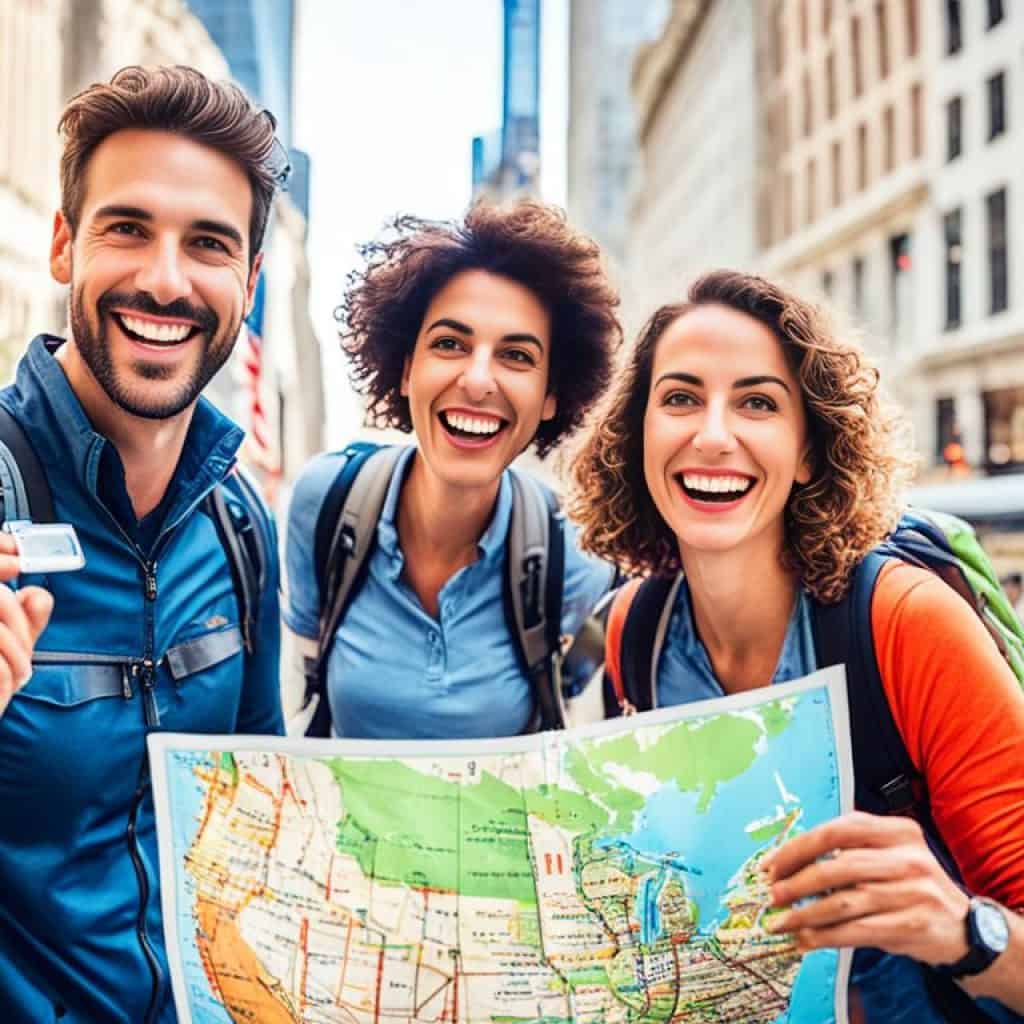
Remember, a strong visa application is essential for a successful visa approval. Take the time to carefully prepare your travel itinerary, gather the necessary financial information, and provide evidence of your ties to your home country. By doing so, you will improve your chances of obtaining a visa to the USA and enjoy a smooth journey to your desired destination.
Navigating the Visa Interview
After submitting your visa application, the next step is to prepare for the crucial visa interview at your local U.S. Embassy or consulate. The interview is an opportunity for the consular officer to ask you questions about your trip and evaluate the information provided in your application. By adequately preparing for the interview, you can feel confident and improve your chances of success.
Preparation is Key
To ensure a successful visa interview, it’s important to review your application details thoroughly. Familiarize yourself with the information you provided and be prepared to discuss it in detail. Additionally, gather all the necessary supporting documents required for your visa type. These documents may include proof of financial capability, flight itineraries, accommodation bookings, and any other supporting documentation relevant to your trip.
Furthermore, practicing your responses to commonly asked questions can help you feel more prepared and confident during the interview. While the specific questions can vary depending on your visa type and individual circumstances, here are some commonly asked questions to consider:
- What is the purpose of your visit to the United States?
- How long do you plan to stay in the United States?
- Do you have any family or friends in the United States?
- What ties do you have to your home country that would ensure your return?
- How will you financially support yourself during your visit?
- Do you have any previous travel history to the United States or other countries?
While it’s important to prepare for these questions, remember to answer truthfully and confidently. Consular officers are trained to assess the credibility of your responses, so honesty is key.
Sample Visa Interview Questions
“What is the purpose of your visit to the United States?”
“How long do you plan to stay in the United States?”
“Do you have any family or friends in the United States?”
“What ties do you have to your home country that would ensure your return?”
“How will you financially support yourself during your visit?”
“Do you have any previous travel history to the United States or other countries?”
Tips for a Successful Visa Interview
Here are some additional tips to help you navigate the visa interview successfully:
- Dress professionally and present yourself in a polite and respectful manner.
- Arrive at least 15 minutes before your scheduled interview time.
- Be prepared to answer questions in English, as the interview will be conducted in English.
- Bring all the required documents, including your passport, visa application confirmation, and supporting documents.
- Stay calm and composed throughout the interview process, even if you feel nervous.
- Provide clear and concise answers to questions, avoiding unnecessary details.
- Address the consular officer by their appropriate title, such as “Sir” or “Madam.”
Remember, the visa interview is an opportunity for the consular officer to assess your eligibility for a visa. By adequately preparing and confidently answering the questions, you can improve your chances of success and secure your visa to enter the United States.
Seeking Guidance from Family and Friends
If you have family members or friends who have previously applied for a U.S. visa, it can be beneficial to seek their guidance. Their personal experiences can provide valuable insights into the visa process and help you understand what to expect.
For example, John Smith, a close friend who recently obtained a U.S. visa, shared his experience navigating the application process, attending the interview, and successfully securing his visa. He emphasized the importance of thorough documentation and preparation, which eased his journey through the process.
Additionally, if you have friends or relatives in the U.S. who you plan to visit, they may be able to provide support by writing a letter of invitation to include in your application. While not required, a letter of invitation can demonstrate that you have a place to stay during your visit.
“Having a letter of invitation from my cousin Sarah, who resides in New York, added credibility to my application. It served as a supporting document that showcased my purpose of travel and established concrete ties to the U.S.,” shared Maria Johnson, a visa applicant who received her visa approval.
“Seeking guidance from family and friends who have gone through the visa application process can provide valuable insights and increase your chances of success. Their firsthand experiences and advice can help you navigate the complexities of the visa journey,” said immigration lawyer, Laura Thompson.
Personal Insights
Personal experiences shared by family and friends can offer unique perspectives and invaluable tips to help you navigate the visa application process. Their guidance can shed light on specific challenges they encountered, highlight potential pitfalls, and provide helpful strategies to overcome them.
Through conversations with friends who have successfully obtained U.S. visas, Sarah Adams learned the importance of preparing well-documented itineraries, demonstrating strong ties to her home country, and effectively articulating her intentions during the visa interview.
Invitations as Supporting Documents
When planning to visit friends or family in the U.S., an invitation letter from your host can enhance your visa application. This letter serves as evidence that you have a place to stay and can provide details about your intended activities while in the United States.
“Including a heartfelt letter of invitation from my sister, who is a U.S. citizen, greatly strengthened my visa application,” shared Daniel Ramirez. “It showcased my purpose of visit, highlighted the close relationship I have with my sister, and gave the consular officer confidence in my intent to return to my home country.”
If you choose to include an invitation letter, ensure that it is authentic, compelling, and contains necessary details such as the host’s contact information, your relationship to the host, and the duration of your visit.
Seek Wisdom from Those Who've Gone Before
Family and friends who have navigated the visa application process before can provide invaluable wisdom and practical advice to help you on your journey. Their experiences can give you confidence, peace of mind, and a roadmap to success.
By leveraging the knowledge and insights from your loved ones, you can approach the visa application process with greater clarity and understanding, increasing your chances of a favorable outcome.
| Benefits of Seeking Guidance from Family and Friends | Personal Experiences | Invitations as Supporting Documents |
|---|---|---|
|
|
|
Understanding Visa Processing Times
When applying for a visa to the USA, it’s important to understand the processing times involved. The duration can vary depending on the type of visa you are applying for. Temporary nonimmigrant visas generally have quicker processing times compared to permanent immigrant visas. On average, a U.S. visa application is processed within 3 to 5 weeks.
However, it’s essential to note that processing times may be longer if additional administrative processing or a waiver of ineligibility is required. These factors can extend the overall processing time. Therefore, it is recommended to apply well in advance to allow for any unexpected delays.
For those eligible for the Visa Waiver Program, there is an option to apply through the Electronic System for Travel Authorization (ESTA). This system allows for a faster processing time, with most applications processed within 24 hours. ESTA is particularly beneficial for individuals looking for a quick approval process.
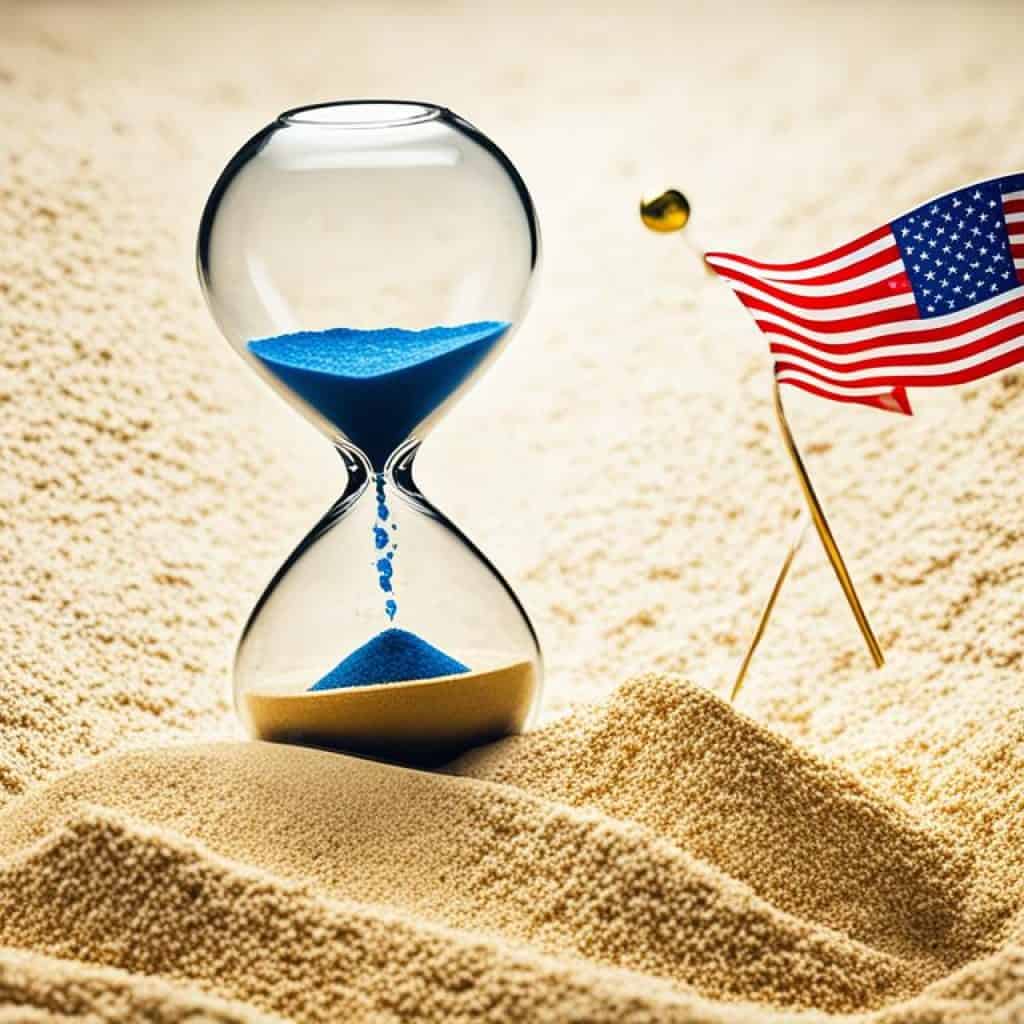
Visa Processing Times - Overview
| Visa Type | Average Processing Time |
|---|---|
| Temporary Nonimmigrant Visa | 3 to 5 weeks |
| Permanent Immigrant Visa | Varies |
| Visa Waiver Program (ESTA) | Within 24 hours |
It’s important to keep in mind that these are average processing times and individual cases may vary. Some visas may be processed faster, while others may take longer, depending on the complexity of the case and the workload of the U.S. embassy or consulate processing the application.
Special Considerations for Different Visa Types
When applying for a visa, it’s important to understand that processing times can vary depending on the type of visa you are applying for. Different visa types have specific requirements and processing times that you should be aware of to ensure a smooth and successful application process.
For example, the processing times for B-1 and B-2 visas, which are commonly used for business and tourism purposes, can range from 2 weeks to several months. The processing time may vary based on the workload of the U.S. embassy or consulate where you submit your application.
On the other hand, visas like the F-1 and F-2 student visas often have faster processing times. In some cases, these visas may even be approved immediately after the visa interview.
To better understand the specific requirements and processing times for the visa type you are applying for, it’s essential to research and consult the official guidelines provided by the U.S. embassy or consulate in your country.
| Visa Type | Processing Time | Specific Requirements |
|---|---|---|
| B-1/B-2 Tourist Visa | 2 weeks to several months | Detailed travel itinerary, financial capability, strong ties to home country |
| F-1/F-2 Student Visa | Varies, may be approved immediately after the interview | Acceptance letter from a U.S. educational institution, financial capability, strong ties to home country |
| E-2 Investor Visa | Varies, may take several weeks to months | Proof of substantial investment in a U.S. business, detailed business plan |
By understanding the specific requirements and processing times for your visa type, you can better prepare yourself and ensure that your application meets all the necessary criteria. It’s also important to submit your application well in advance to allow for any potential delays or additional processing time.
Remember, each visa type has its own unique considerations, so it’s crucial to research and gather all the required documentation to support your application. This will help increase your chances of obtaining the visa and pave the way for a successful journey to the United States.
Applying for a Visitor Visa
When it comes to applying for a visitor visa to the United States, there are a few key steps you need to follow. By understanding the process and having all the required documents in order, you can increase your chances of a successful application. Here’s a breakdown of what you need to do:
Step 1: Complete the Online Application
To start the process, you’ll need to fill out the online Nonimmigrant Visa Application, Form DS-160. This form collects your personal information and details about your trip to the United States. Make sure to provide accurate and complete information.
Step 2: Schedule an Interview
After completing the online application, you’ll need to schedule an interview at a U.S. Embassy or Consulate. The interview is an opportunity for a consular officer to assess your eligibility for the visa. It’s important to schedule the interview as soon as possible, as wait times can vary.
Step 3: Gather the Required Documentation
Along with completing the application and scheduling an interview, you’ll need to gather all the required documentation. This includes:
- A valid passport, with a validity that extends beyond your intended stay in the United States.
- The application fee payment receipt, which confirms that you’ve paid the necessary fees.
- Additional supporting documents that demonstrate the purpose of your trip and your intent to return to your home country. This may include a detailed travel itinerary, proof of financial capability, and evidence of ties to your home country.
Each visa applicant, including any family members listed in your passport, must submit a separate application. Make sure to carefully review the requirements and gather all the necessary documents before your interview.
Attending the Visa Interview
The visa interview is a crucial part of the application process, where a consular officer will assess your eligibility for a visa. This interview is typically required for visa applicants aged 14 to 79, with some exceptions. It is essential to carefully review the instructions provided by the U.S. embassy or consulate and be fully prepared with all the required documents to ensure a successful interview.
During the interview, you will be required to present the necessary documents and answer questions pertaining to your intended trip and ties to your home country. It is crucial to demonstrate your genuine intent to visit the United States temporarily and your ability to return to your home country after your visit. Remember to remain calm, confident, and honest during the interview process.
Interview Requirements:
- A valid passport: Your passport should be valid for at least six months beyond the intended period of stay in the United States.
- Appointment confirmation: Make sure to have the confirmation of your visa interview appointment.
- DS-160 confirmation page: Bring the confirmation page of your Nonimmigrant Visa Application, Form DS-160.
- Application fee payment receipt: Carry the receipt that confirms your payment of the visa application fee.
- Supporting documents: Prepare all the required supporting documents, such as a detailed travel itinerary, financial records, employment documents, and proof of ties to your home country.
These are general requirements, and additional documents may be requested based on your specific circumstances or the visa category you are applying for. It is crucial to consult the official guidelines provided by the U.S. embassy or consulate in your country for accurate information.
“The visa interview is your opportunity to demonstrate your eligibility and intent to visit the United States. Be well-prepared, organized, and truthful in your responses to the consular officer’s questions.” – John Smith, Immigration Attorney
| Key Tips for a Successful Visa Interview |
|---|
| 1. Dress professionally and maintain a confident yet polite demeanor. |
| 2. Review and practice answering commonly asked interview questions. |
| 3. Be concise and provide clear, honest, and consistent answers. |
| 4. Bring original documents and organized copies for easy reference. |
| 5. Express your purpose of travel and ties to your home country convincingly. |
Remember that the consular officer’s primary goal is to ensure the integrity of the visa process and determine whether you meet the requirements for a temporary visit. By thoroughly preparing for the interview, presenting the required documents, and confidently conveying your intentions, you can greatly enhance your chances of obtaining a U.S. visa.
Entering the United States
Once you have been granted a visa and arrive at a U.S. port-of-entry, you will begin the admission process. At this point, U.S. Customs and Border Protection officials have the authority to permit or deny entry into the United States. To ensure a smooth entry, it is crucial to understand and meet the entry requirements.
First and foremost, you will need to present a valid passport that meets the expiration requirements set by the U.S. government. Additionally, depending on your visa type, you may be required to provide specific supporting documents such as a return ticket, proof of accommodation, or evidence of financial solvency.
Compliance with customs and immigration regulations is of utmost importance. Adhere to any instructions provided by the officials and be prepared to answer any questions they may have about your purpose of visit, duration of stay, and ties to your home country.
The admission process can be straightforward and hassle-free if you have all the necessary documentation in order and demonstrate your compliance with the entry requirements. This will ensure a warm welcome into the United States, allowing you to embark on your journey in this vibrant and diverse country.
Remember, smooth entry into the United States begins with proper preparation and adherence to the entry requirements at the port-of-entry.
Key Entry Requirements:
- A valid passport that meets U.S. government requirements
- Specific supporting documents related to your visa type
- Compliance with customs and immigration regulations
Benefits of Meeting Entry Requirements:
“Ensuring that you meet the entry requirements provides a smooth and hassle-free experience upon arrival in the United States. By presenting the necessary documents and demonstrating your compliance, you provide the customs officials with a clear understanding of your purpose of visit and facilitate a warm welcome into the country.”
Below is a table summarizing the key entry requirements for a seamless process at the port-of-entry:
| Entry Requirement | Details |
|---|---|
| Valid Passport | Ensure your passport meets the U.S. government’s requirements for expiration and validity. |
| Supporting Documents | Have any required supporting documents, such as return tickets, proof of accommodation, or financial evidences readily available. |
| Compliance with Customs and Immigration Regulations | Adhere to any instructions given by customs officials and be prepared to answer questions about your visit and ties to your home country. |
Ensuring you meet the entry requirements and have all the necessary documents will help make your journey through the port-of-entry a seamless and welcoming experience. Compliance with customs and immigration regulations is essential for a smooth entry into the United States.
Extending Your Stay
If you wish to extend your stay beyond the initial period indicated on your admission stamp or paper Form I-94, you may be able to request an extension of stay through U.S. Citizenship and Immigration Services (USCIS). It’s important to be aware of the process and requirements for extending your stay to ensure a smooth transition and avoid any complications.
Failure to depart the United States on time can result in being out of status, which may have implications for future visa applications. By following the correct procedures, you can maintain your legal status and continue enjoying your time in the United States.
Requesting an Extension of Stay
When requesting an extension of stay, you will need to submit a Form I-539 to USCIS before your current visa expiration date. The form should be completed accurately and include all the required documentation to support your request. It is essential to review the guidelines provided by USCIS to ensure your application is complete and meets the necessary criteria.
The USCIS process for extending your stay can vary depending on your visa category and specific circumstances. It’s recommended to consult with an immigration attorney or seek professional advice to navigate through the process successfully.
Documentation Required
When submitting your request for an extension of stay, it is crucial to include the following documents:
- A completed Form I-539
- Proof of financial support to cover your extended stay
- Evidence of ties to your home country, to demonstrate your intention to return after your extended stay
- Valid passport
- Any other supporting documents related to your visa category or specific circumstances
It’s important to provide all the necessary documentation to ensure that your application is complete and has the highest chance of being approved.
Processing Time and Decision
The processing time for an extension of stay can vary. Delays may occur due to the volume of applications received by USCIS or additional review required for specific cases. Therefore, it’s advisable to submit your application well in advance of your visa expiration date to allow sufficient time for processing.
After reviewing your application, USCIS will make a decision and notify you of the outcome. If approved, you will receive a new Form I-94 reflecting the extended period of stay. It’s essential to keep a copy of this approval notice for your records and to provide it if requested by immigration officials during your stay in the United States.
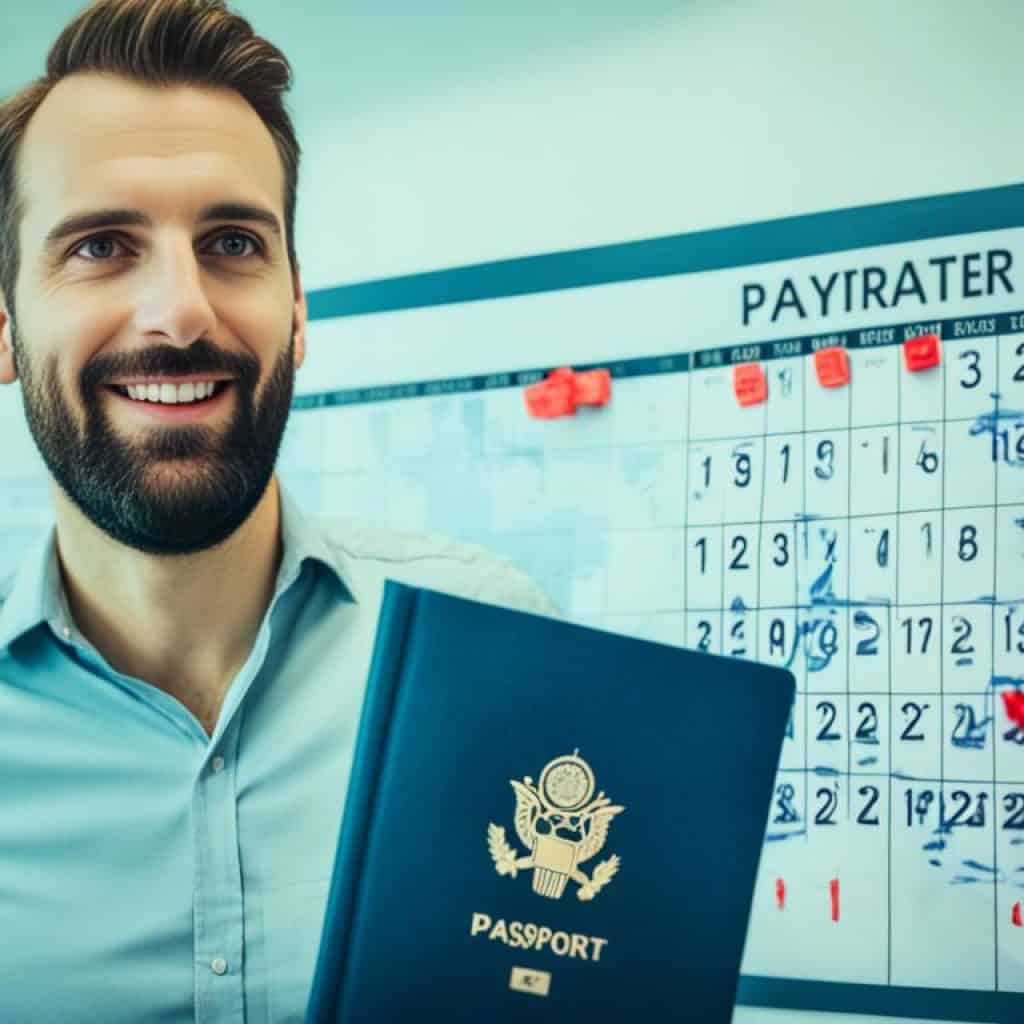
Summary: Extending Your Stay
When planning your stay in the United States, it’s important to be aware of the expiration date on your visa and take the necessary steps to extend your stay if needed. By following the USCIS process, submitting your application with the required documentation, and allowing ample processing time, you can increase your chances of obtaining an extension and enjoy your time in the United States without any legal complications.
Change of Status
If your plans change while you are in the United States and you need to change your nonimmigrant status to another category, you can request a change of status through USCIS. This process allows you to transition from one visa category to another, such as transitioning from a tourist visa to a student visa. However, it is important to note that once you leave the United States, you will need to apply for a new visa in the appropriate category to reenter.
Change of Status Process
If you find the need to change your nonimmigrant status while in the United States, you must follow the USCIS process for a successful transition. Here are the steps involved:
- Gather necessary documents: Prepare all the required documents, including a completed Form I-539, Application to Extend/Change Nonimmigrant Status, your current visa, passport, and supporting evidence for the new visa category.
- Submit your application: Complete the Form I-539 accurately and submit it to USCIS along with the required filing fee. Ensure that all the necessary supporting documents are included in your application package.
- Attend biometrics appointment: USCIS will schedule a biometrics appointment for you to have your fingerprints taken. This information will be used for background checks as part of the evaluation process.
- Wait for a decision: After your biometrics appointment, USCIS will review your application and supporting documents. The processing time can vary, but you can check the USCIS website for estimated processing times.
- Receive a decision: USCIS will notify you of their decision by mail. If approved, you will receive an approval notice and a new I-94 Arrival/Departure Record indicating your new status. If denied, USCIS will provide the reasons for the denial and you may need to explore other options.
It’s important to note that while your change of status application is pending, you must maintain your current nonimmigrant status. If your current status expires before a decision is made on your change of status application, you may be considered out of status and could face immigration consequences. It is advisable to consult an immigration attorney to navigate the change of status process successfully.
| Advantages of Change of Status | Disadvantages of Change of Status |
|---|---|
|
|
Additional Information
A visitor visa allows individuals to engage in various activities in the United States for business or pleasure. However, it is important to be aware of the restrictions associated with a visitor visa and ensure that you apply for the appropriate visa category for specific activities. Some activities, such as studying or working, require different visa categories and cannot be done on a visitor visa. Understanding these restrictions will help you navigate the visa application process smoothly and avoid any complications during your stay.
Visitor Visa Activities:
- Visiting friends or family
- Tourism and sightseeing
- Attending business meetings or conferences
- Attending cultural or sports events
- Medical treatments
- Participating in voluntary or charitable activities
- Short-term educational courses, not for credit
Restrictions:
While a visitor visa allows for a wide range of activities, it is important to note that there are certain activities that require different visa categories. Some common examples include:
“I wanted to pursue a short course at a university during my visit to the United States. However, I soon realized that a visitor visa does not allow for full-time study. I had to apply for an appropriate student visa to pursue my educational goals.”
| Visitor Visa Activities | Required Visa Category |
|---|---|
| Tourism or Sightseeing | B-2 |
| Studying full-time | F-1 |
| Temporary work or business-related activities | B-1 |
| Participating in an exchange program | J-1 |
Birth Tourism:
It is worth noting that the U.S. government does not issue visitor visas for the purpose of birth tourism. Birth tourism refers to the practice of traveling to the United States with the intention of giving birth and obtaining U.S. citizenship for the child. It is important to apply for the appropriate visa category and adhere to the intended purpose of your visit when applying for a visa to the United States.
Conclusion
Applying for a visa to the USA can be a complex process, but with the right preparation and understanding of the requirements, it can be simplified. By creating a strong visa application, preparing for the visa interview, and following the necessary steps, you can increase your chances of obtaining a visa to enter the United States.
Remember to review the specific requirements for your visa type and consult the official guidelines provided by the U.S. embassy or consulate in your country. This will ensure that you have all the necessary documentation and meet all the necessary criteria for a successful visa application.
Start your visa application process today and embark on your journey to the USA! Whether you’re planning a business trip or a vacation, taking the time to understand the visa application process and preparing accordingly will make the process smoother and more efficient. Don’t miss out on the opportunity to experience all that the United States has to offer. Apply for your visa today and get ready to create unforgettable memories in the Land of Opportunity!
FAQ
What is a visum?
A visum is a visa, which is a document that allows individuals to enter the United States for a temporary period.
What is a B-1/B-2 tourist visa?
The B-1/B-2 tourist visa is a nonimmigrant visa that allows individuals to temporarily enter the United States for business or tourism purposes.
What are the requirements for a B-1/B-2 tourist visa?
The requirements for a B-1/B-2 tourist visa include providing a detailed travel itinerary, demonstrating financial capability to cover trip expenses, and proving ties to your home country.
How can I create a strong visa application?
To create a strong visa application, you should provide a detailed travel itinerary, gather financial information, and demonstrate strong ties to your home country.
What should I expect during the visa interview?
During the visa interview, a consular officer will ask you questions about your trip and evaluate the information provided in your application.
Can my family and friends provide support during the visa application process?
Yes, your family and friends can provide guidance based on their personal experiences and may also write a letter of invitation.
How long does the visa processing time take?
The visa processing time can vary, but on average, it takes 3 to 5 weeks for a U.S. visa application to be processed.
What are the specific requirements for different visa types?
Different visa types have specific requirements and processing times, so it’s important to understand them before applying.
How do I apply for a visitor visa?
To apply for a visitor visa, you need to complete the online Nonimmigrant Visa Application, Form DS-160, and schedule an interview at a U.S. Embassy or Consulate.
What happens during the visa interview?
During the visa interview, a consular officer will assess your eligibility for a visa and ask questions about your intended trip and ties to your home country.
What do I need to enter the United States?
To enter the United States, you will need a valid passport and any additional documents specific to your visa type.
Can I extend my stay in the United States?
If you want to extend your stay, you may be able to request an extension of stay through U.S. Citizenship and Immigration Services (USCIS).
Can I change my nonimmigrant status while in the United States?
Yes, you can request a change of status through USCIS, but once you leave the United States, you will need to apply for a new visa in the appropriate category to reenter.
Are there any restrictions on a visitor visa?
Yes, a visitor visa is specifically for business or pleasure purposes, and certain activities like study or employment require different visa categories.
How can I apply for a visa to the USA?
You can start your visa application process by completing the required forms and gathering the necessary documentation. Consult the official guidelines provided by the U.S. embassy or consulate in your country for detailed instructions.
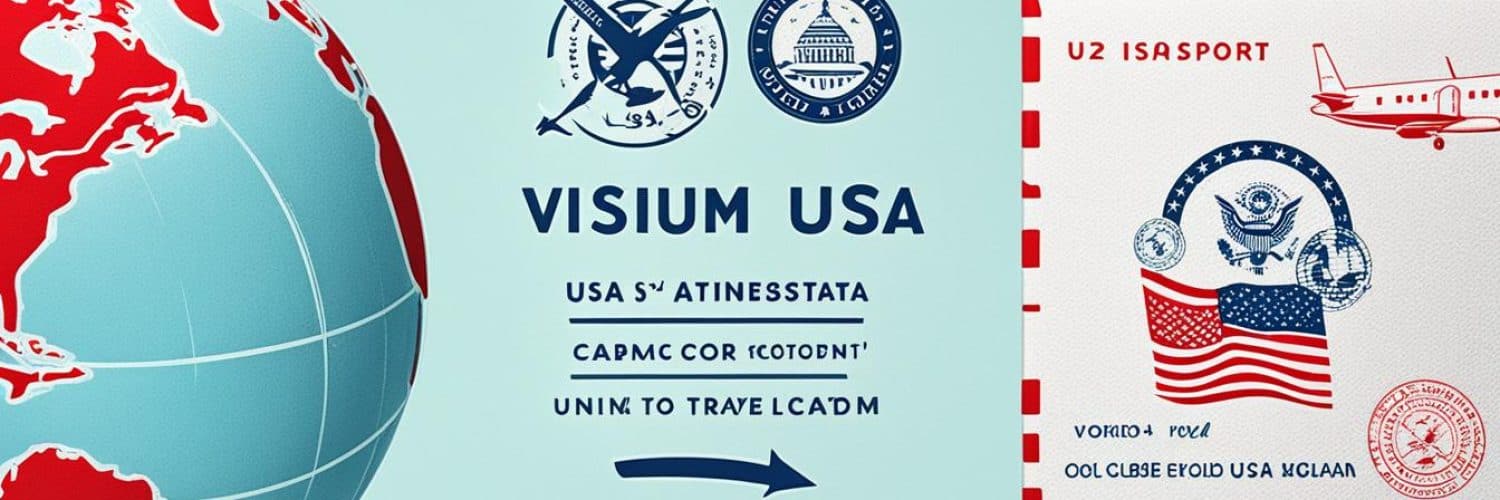
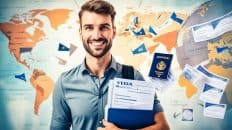






Add comment